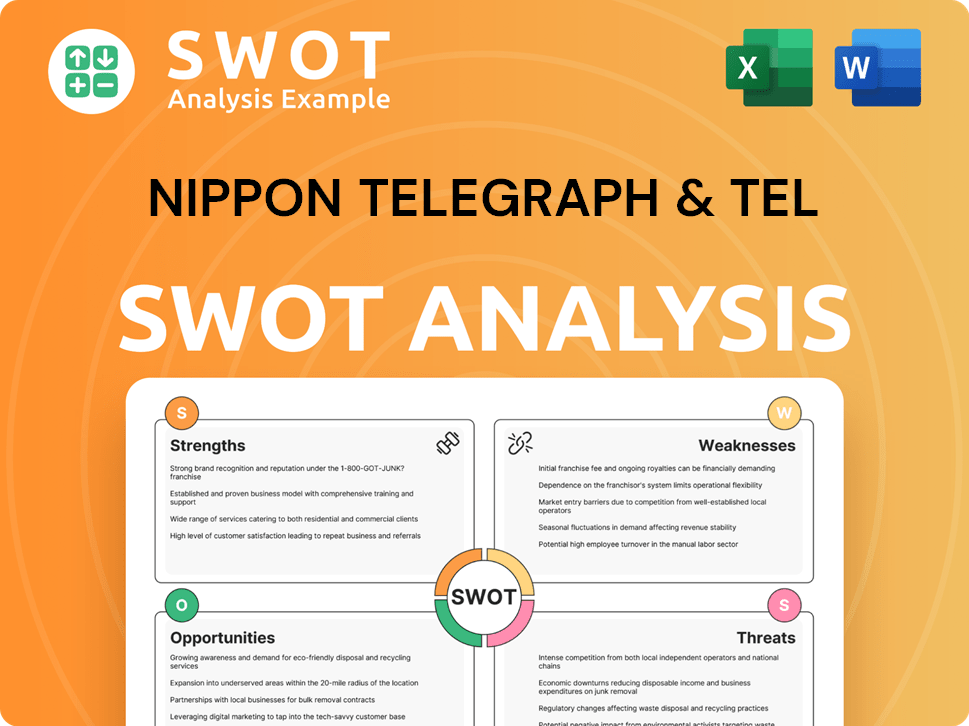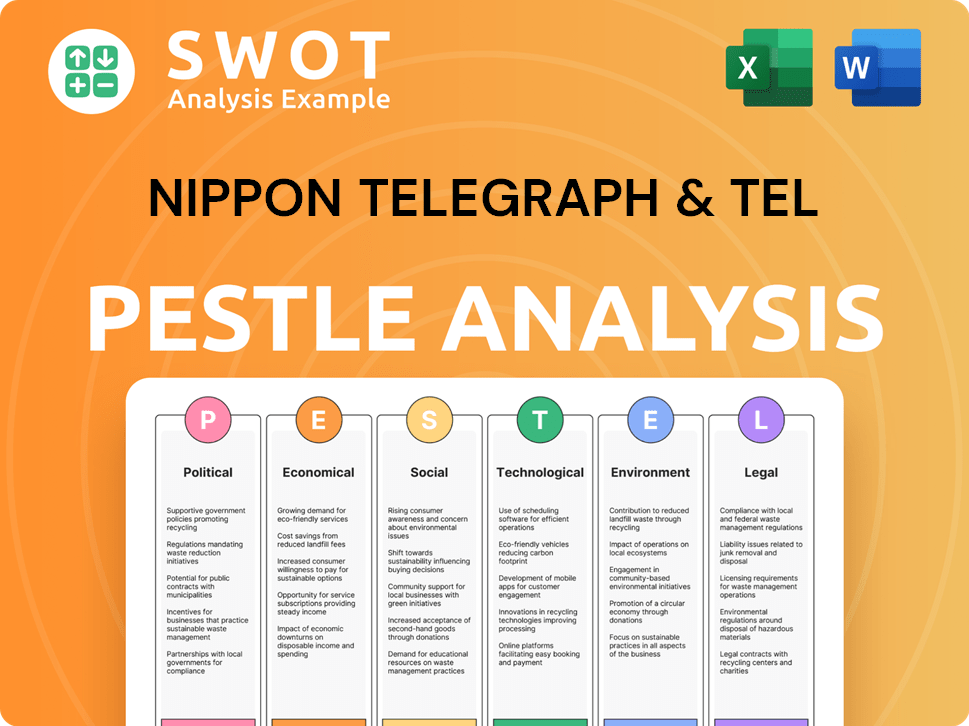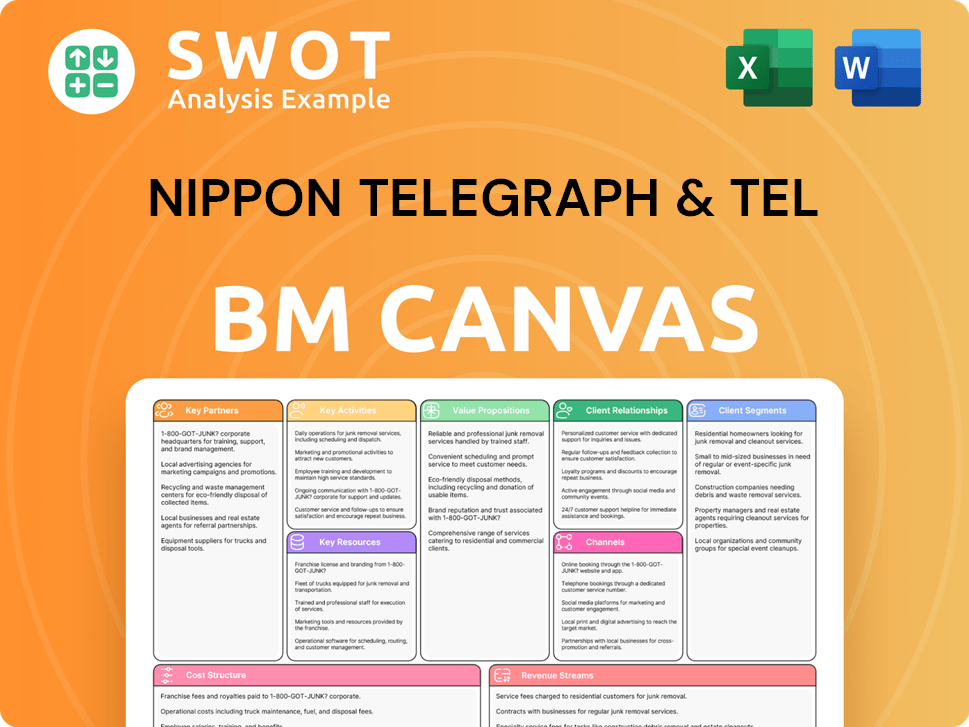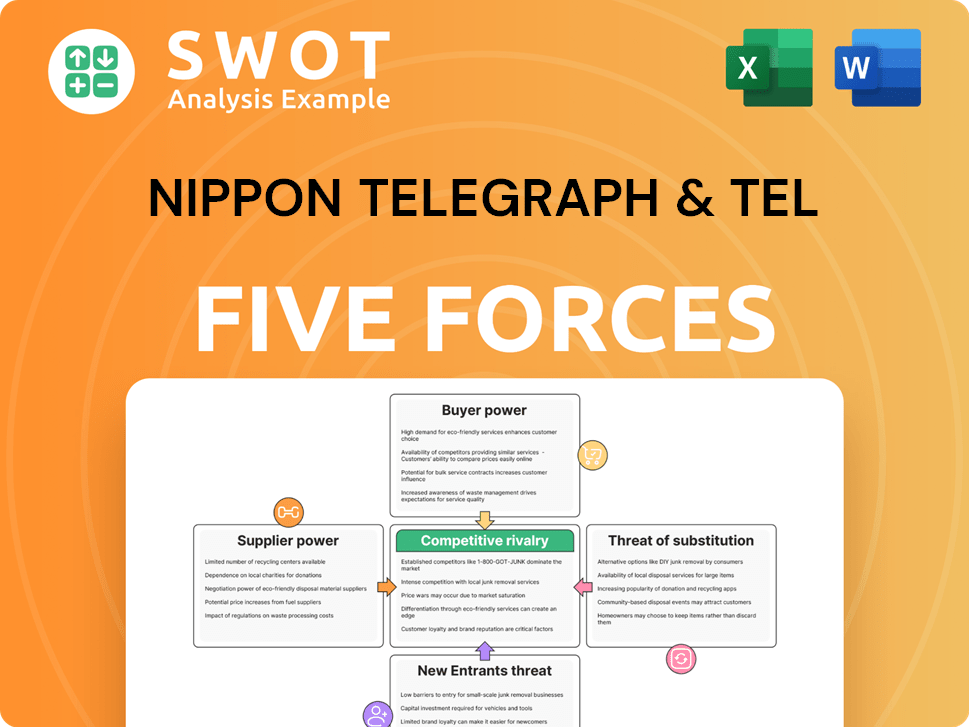Nippon Telegraph & Tel Bundle
Can NTT Conquer the Telecom Titans?
The telecom industry is a battlefield of innovation and fierce competition, and at the heart of it all stands Nippon Telegraph & Tel Company (NTT). With the rise of 5G, IoT, and the insatiable demand for data, the stakes have never been higher. Understanding the Nippon Telegraph & Tel SWOT Analysis is crucial for anyone seeking to navigate this complex landscape.

This analysis will dissect the NTT competitive landscape, exploring its key rivals and strategic moves. We'll examine NTT's market share, its position within the Telecom industry in Japan, and its global market presence. Furthermore, we'll investigate the competitive advantages NTT wields and how it stacks up against competitors like KDDI, providing a comprehensive view of its financial performance and strategic partnerships in this dynamic sector.
Where Does Nippon Telegraph & Tel’ Stand in the Current Market?
The Nippon Telegraph & Tel Company (NTT) holds a strong market position, particularly within Japan's telecom sector. Through subsidiaries like NTT Docomo for mobile services and NTT East/West for fixed-line services, the company maintains significant market share. NTT's competitive landscape is shaped by its diverse operations, including IT services, cloud computing, and global data center operations, expanding its reach beyond traditional telecom offerings.
NTT's value proposition centers on providing comprehensive telecommunications and IT solutions to a broad customer base. This includes individual consumers, large enterprises, and government entities. The company emphasizes higher-value services, such as digital transformation consulting and managed services, to capture a larger share of the enterprise IT spending market. This strategic shift helps NTT maintain its competitive edge in a rapidly evolving industry.
NTT's global presence extends across North America, Europe, and Asia, reflecting its commitment to serving international markets. The company’s financial performance, with an operating income of approximately 1.7 trillion JPY for the fiscal year ended March 31, 2024, underscores its scale and profitability. While it faces competition, particularly in international consumer mobile markets, NTT's diversified portfolio and strategic focus on enterprise solutions support its market position.
In Japan, NTT, through its subsidiaries, commands a substantial market share in both fixed-line and mobile services. NTT Docomo is a leading mobile carrier. The company's strong domestic presence provides a solid foundation for its broader business operations. The competitive landscape is shaped by the presence of other major players like KDDI (au) and SoftBank.
NTT has a significant global presence, especially in enterprise solutions and data centers. NTT DATA is a major player in the global IT services market, ranking among the top IT service providers worldwide. This global reach enables NTT to serve a diverse range of customers and compete effectively in international markets.
NTT has strategically diversified into IT services, cloud computing, and global data center operations. This diversification allows the company to capture a larger share of the enterprise IT spending market. This move is crucial for sustaining growth and competitiveness in the evolving telecom industry.
NTT's financial scale is considerable, with a reported operating income of 1.7 trillion JPY for the fiscal year ended March 31, 2024. This strong financial performance reflects its robust market position and effective business strategies. The financial health supports investments in new technologies and services.
The NTT competitive landscape includes major rivals like KDDI (au) and SoftBank in the Japanese mobile market. Globally, NTT competes with a range of IT service providers and data center operators. The company faces intense competition in certain international consumer mobile markets.
- KDDI (au) and SoftBank are key competitors in the Japanese telecom market.
- NTT DATA competes with global IT service providers.
- Competition is particularly strong in international consumer mobile markets.
- NTT's strategic focus on enterprise solutions helps it maintain a competitive edge.
Nippon Telegraph & Tel SWOT Analysis
- Complete SWOT Breakdown
- Fully Customizable
- Editable in Excel & Word
- Professional Formatting
- Investor-Ready Format

Who Are the Main Competitors Challenging Nippon Telegraph & Tel?
The NTT competitive landscape is shaped by a diverse array of rivals across its various business sectors. In the Japanese telecom market, NTT's competitors include established players like KDDI and SoftBank. Globally, NTT faces competition from IT service providers, cloud specialists, and data center operators.
Understanding the competitive dynamics is crucial for evaluating NTT's market share and strategic positioning. The company's ability to innovate, adapt, and form strategic alliances will be key to maintaining its competitive edge. The rise of new technologies and evolving customer demands further complicate the competitive environment.
For a deeper dive into how NTT plans to grow, check out this analysis: Growth Strategy of Nippon Telegraph & Tel.
In Japan, KDDI and SoftBank are NTT's primary competitors. KDDI, operating under the 'au' brand, directly competes in mobile services. SoftBank also offers mobile and fixed-line services and has a significant presence in tech investments.
NTT DATA competes with global IT service providers. Key rivals include Accenture, IBM, and Fujitsu. These companies compete for large digital transformation projects and cybersecurity contracts.
In the data center market, NTT Global Data Centers faces competition from major hyperscale providers. Equinix, Digital Realty, and Amazon Web Services (AWS) are key rivals. These competitors challenge NTT through their global reach and pricing strategies.
Cloud-native companies and specialized AI solution providers are emerging competitors. These companies push NTT to innovate and integrate advanced technologies. Mergers and alliances reshape the competitive landscape.
NTT Docomo, a subsidiary of NTT, is actively involved in 5G deployment in Japan. KDDI and SoftBank are also heavily investing in 5G infrastructure. The competition for 5G market share is intense.
NTT's fiber optic network is a key asset in the fixed-line market. Competitors like KDDI and SoftBank also offer fiber optic services. NTT's competitive advantage lies in its extensive fiber infrastructure.
Several factors influence NTT's competitive landscape. These include pricing strategies, network coverage, service offerings, and technological innovation. NTT's competitors continually invest in these areas to gain market share.
- Pricing: Competitive pricing plans are essential for attracting and retaining customers.
- Network Coverage: Extensive network coverage, particularly 5G, is a key differentiator.
- Service Offerings: Bundling services and offering value-added services enhance competitiveness.
- Technological Innovation: Investing in new technologies, such as AI and cloud services, is crucial.
Nippon Telegraph & Tel PESTLE Analysis
- Covers All 6 PESTLE Categories
- No Research Needed – Save Hours of Work
- Built by Experts, Trusted by Consultants
- Instant Download, Ready to Use
- 100% Editable, Fully Customizable

What Gives Nippon Telegraph & Tel a Competitive Edge Over Its Rivals?
The competitive landscape for Nippon Telegraph & Tel Company (NTT) is shaped by its substantial infrastructure, technological innovations, and diverse business portfolio. NTT's strategic moves and competitive edge have evolved from its origins as a national telecommunications provider to a global ICT leader. The company consistently leverages its core strengths to adapt to market demands and maintain a leading edge, making it a key player in the telecom industry in Japan and globally.
NTT's competitive advantages are multifaceted, including its extensive telecommunications infrastructure, particularly in Japan. This infrastructure provides a strong base for delivering high-speed, reliable connectivity services. Additionally, NTT's long-standing commitment to research and development (R&D) through NTT Laboratories is a key differentiator, investing in cutting-edge technologies like photonics and AI. For a deeper dive into the company's growth strategy, consider reading about the Growth Strategy of Nippon Telegraph & Tel.
Brand equity and customer loyalty, especially in Japan, are significant advantages for NTT. For example, NTT DoCoMo benefits from a strong brand reputation, fostering a loyal customer base. The company's economies of scale, derived from its massive operational size and global reach, allow it to achieve cost efficiencies and offer competitive pricing. These elements collectively position NTT strongly within the NTT competitive landscape.
NTT's extensive fiber optic networks and expanding 5G footprint provide a robust foundation. The company invests heavily in R&D, focusing on photonics, quantum computing, and AI. This technological prowess enables NTT to integrate innovations into its services, maintaining a competitive edge.
NTT Docomo's strong brand reputation fosters a loyal customer base. This brand equity is a key advantage in the Japanese telecom market. Customer loyalty contributes significantly to NTT's market share and overall financial performance.
NTT's diversified business model includes fixed and mobile communications, system integration (NTT DATA), and global data centers. This diversity provides resilience against market fluctuations. The company's global presence allows it to serve clients worldwide.
NTT's massive operational size and global reach enable significant cost efficiencies. This allows the company to offer competitive pricing across various services. Economies of scale are a critical factor in NTT's financial performance compared to competitors.
NTT's competitive advantages stem from its robust infrastructure, technological innovation, and diversified business model. These strengths enable NTT to maintain a leading position in the telecom industry. The company's focus on R&D and strategic partnerships further enhances its competitive edge.
- Infrastructure: Extensive fiber optic networks and 5G deployment in Japan.
- Technology: Investments in photonics, quantum computing, and AI through NTT Laboratories.
- Brand: Strong brand reputation and customer loyalty, particularly with NTT Docomo.
- Diversification: Broad business portfolio including fixed and mobile communications, system integration, and global data centers.
Nippon Telegraph & Tel Business Model Canvas
- Complete 9-Block Business Model Canvas
- Effortlessly Communicate Your Business Strategy
- Investor-Ready BMC Format
- 100% Editable and Customizable
- Clear and Structured Layout

What Industry Trends Are Reshaping Nippon Telegraph & Tel’s Competitive Landscape?
The telecommunications and IT services sectors are undergoing significant transformations, shaping the competitive landscape for Nippon Telegraph & Tel Company (NTT). These changes present both challenges and opportunities for NTT, influencing its strategic direction and market position. Analyzing the NTT competitive landscape involves understanding industry trends, identifying key competitors, and assessing NTT's ability to adapt and innovate.
NTT's position in the Japanese telecom market and its global presence are influenced by technological advancements, regulatory changes, and economic factors. The company faces various risks, including intense competition, the need for substantial capital investments, and the ever-present threat of cyberattacks. However, the future outlook for NTT remains positive, driven by its investments in emerging technologies and strategic partnerships.
The adoption of 5G technology is a major trend, creating opportunities for new services such as IoT solutions and private 5G networks. The demand for cloud computing and data center services is growing, driven by digital transformation initiatives. NTT is well-positioned to capitalize on these trends through its global data center expansion and hybrid cloud solutions.
Increasing network infrastructure complexity and cyber threats demand continuous investment in cybersecurity. Intense price competition in mature markets and the high capital expenditure for 5G deployment put pressure on profitability. Regulatory changes, especially concerning data privacy and anti-trust measures, pose potential threats to global operations.
Emerging technologies like generative AI and quantum computing offer competitive advantages through R&D. Strategic partnerships and mergers can expand global reach, particularly in sectors like smart cities and healthcare. NTT can evolve into a more integrated ICT solutions provider, leveraging its network infrastructure and IT services capabilities.
NTT's strategy must focus on continuous innovation, global expansion, and robust cybersecurity. The company needs to adapt to evolving market dynamics and technological advancements. Strengthening its position in the Japanese telecom market requires a focus on customer needs and competitive pricing.
NTT's ability to navigate the NTT competitive landscape depends on several factors. These include its investment in 5G infrastructure, its expansion of data center capacity, and its ability to offer competitive cloud services. The company must also address cybersecurity threats and adapt to regulatory changes to maintain its market position.
- 5G Deployment: NTT is investing heavily in 5G, with plans to expand its network and offer new services. According to recent reports, NTT plans to invest billions of dollars in its 5G infrastructure.
- Data Center Expansion: NTT Global Data Centers is expanding its global footprint to meet the growing demand for cloud services. The company is focusing on building new data centers in strategic locations.
- Cybersecurity: With cyber threats increasing, NTT is investing in robust cybersecurity measures to protect its networks and customers. The company is also working to develop new cybersecurity solutions.
- Strategic Partnerships: NTT is forming strategic partnerships to expand its reach and offer comprehensive solutions. Recent partnerships include collaborations in the areas of AI and IoT.
Nippon Telegraph & Tel Porter's Five Forces Analysis
- Covers All 5 Competitive Forces in Detail
- Structured for Consultants, Students, and Founders
- 100% Editable in Microsoft Word & Excel
- Instant Digital Download – Use Immediately
- Compatible with Mac & PC – Fully Unlocked

Related Blogs
- What are Mission Vision & Core Values of Nippon Telegraph & Tel Company?
- What is Growth Strategy and Future Prospects of Nippon Telegraph & Tel Company?
- How Does Nippon Telegraph & Tel Company Work?
- What is Sales and Marketing Strategy of Nippon Telegraph & Tel Company?
- What is Brief History of Nippon Telegraph & Tel Company?
- Who Owns Nippon Telegraph & Tel Company?
- What is Customer Demographics and Target Market of Nippon Telegraph & Tel Company?
Disclaimer
All information, articles, and product details provided on this website are for general informational and educational purposes only. We do not claim any ownership over, nor do we intend to infringe upon, any trademarks, copyrights, logos, brand names, or other intellectual property mentioned or depicted on this site. Such intellectual property remains the property of its respective owners, and any references here are made solely for identification or informational purposes, without implying any affiliation, endorsement, or partnership.
We make no representations or warranties, express or implied, regarding the accuracy, completeness, or suitability of any content or products presented. Nothing on this website should be construed as legal, tax, investment, financial, medical, or other professional advice. In addition, no part of this site—including articles or product references—constitutes a solicitation, recommendation, endorsement, advertisement, or offer to buy or sell any securities, franchises, or other financial instruments, particularly in jurisdictions where such activity would be unlawful.
All content is of a general nature and may not address the specific circumstances of any individual or entity. It is not a substitute for professional advice or services. Any actions you take based on the information provided here are strictly at your own risk. You accept full responsibility for any decisions or outcomes arising from your use of this website and agree to release us from any liability in connection with your use of, or reliance upon, the content or products found herein.